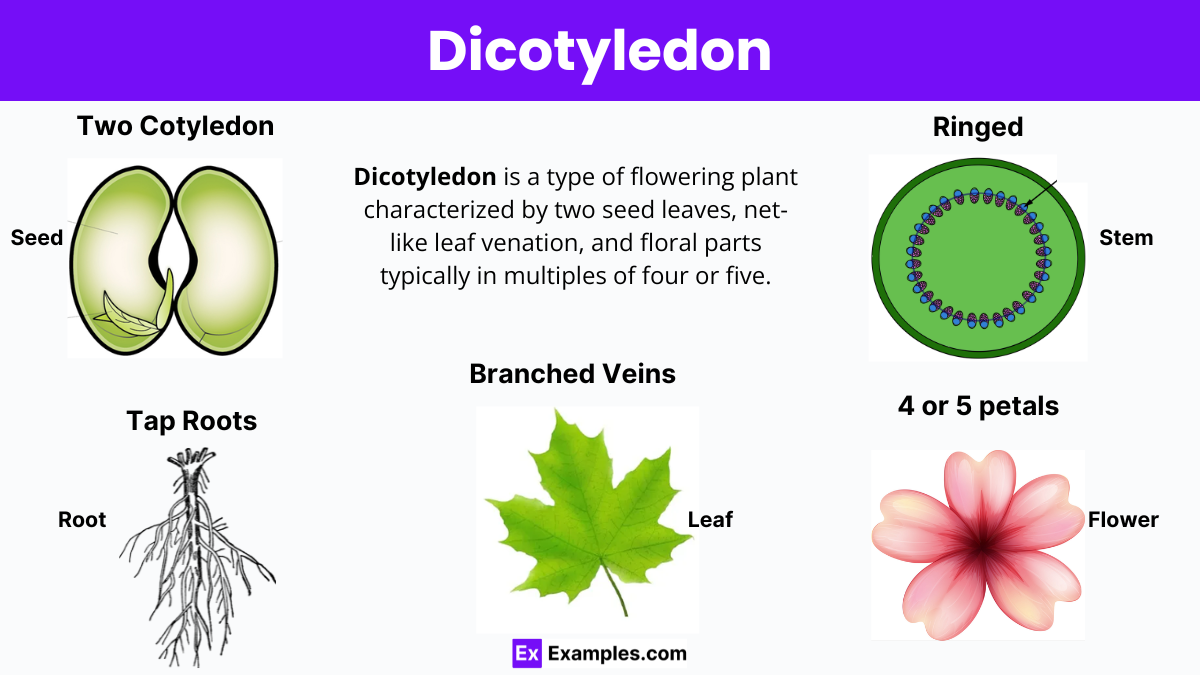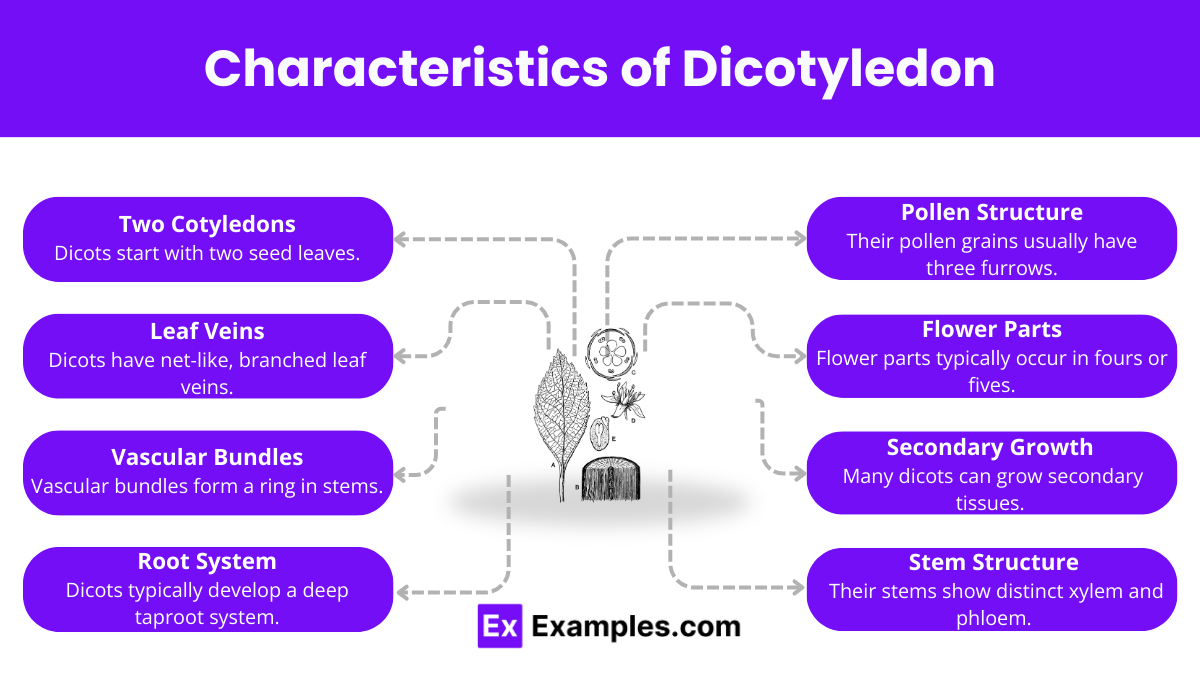Which of the following is a characteristic of dicotyledons?
Single seed leaf
Parallel leaf veins
Two seed leaves
Fibrous root system


Dicotyledons, commonly known as dicots, represent a large and diverse group within the flowering plants, or angiosperms. Traditionally, angiosperms were classified into two main groups: dicots and monocotyledons (monocots). The defining characteristic of dicots is that their seeds contain two embryonic leaves, known as cotyledons, which is a crucial feature distinguishing them from monocots that typically have just one. Dicots comprise approximately 200,000 species, showcasing a vast array of forms, structures, and functions across the botanical spectrum.
A dicotyledon, or dicot, is a type of flowering plant (angiosperm) distinguished by two embryonic leaves or cotyledons in the seed. Comprising about 175,000 species, dicots include common garden plants, trees, and broad-leaved flowers like magnolias and roses. They feature floral parts in multiples of four or five, net-veined leaves, and a ring of vascular tissues in the stem. Dicots are often woody, with branching stems and taproots.
Dicotyledon plants, commonly known as dicots, are one of the two major groups of flowering plants. They are characterized by having two seed leaves, or cotyledons, which provide the initial nutrients to the plant as it grows. Below, we explore a variety of dicot plants, spanning from common garden varieties to significant agricultural crops.
Sunflowers are not only popular for their beauty but also for their seeds, which are used for producing sunflower oil and snacks. These tall plants are easily recognizable by their large, golden flowers and are native to North America.
Roses are one of the most beloved flowers worldwide. Known for their intricate petals and fragrant blooms, they are a staple in gardens and floral arrangements. Roses come in many varieties and colors, each with their own unique characteristics.
Tomatoes are a fundamental ingredient in cuisines around the world, particularly in Mediterranean dishes. They grow on vines and are technically fruits, though they are commonly used as vegetables in cooking.
Oak trees are sturdy, deciduous trees widely found in northern hemispheres. They are valued for their strong wood and the ecological support they provide, hosting numerous species of birds and insects.
Peas are both a garden favorite and an agricultural crop. These green, pod-shaped vegetables are grown globally and are consumed in a multitude of dishes, fresh, frozen, or canned.
Maple trees are known for their distinctive leaf shape and for producing maple syrup, a popular natural sweetener. These trees display stunning fall foliage, making them highly valued for both aesthetic and commercial reasons.
Daisies are charming, small white flowers with a yellow center, commonly found in meadows and gardens. They are often associated with purity and innocence.
Carrots are a root vegetable favored for their health benefits and versatility in cooking. They are rich in beta-carotene, which the body converts into vitamin A.
Apple trees are cultivated worldwide for their fruit, which is enjoyed fresh, in ciders, or in a myriad of baked goods. Each variety offers a different balance of sweetness and tartness, making them highly versatile in culinary uses.
Beans are a staple protein source in many diets around the globe. They come in various forms, including kidney beans, black beans, and pinto beans, each with distinct flavors and uses in different culinary traditions.

Dicotyledons, commonly known as dicots, belong to one of the two major groups of flowering plants. Several distinct features differentiate them from monocotyledons (monocots). Below are the primary characteristics that define dicots:
Dicots get their name from their two cotyledons, or seed leaves. These cotyledons act as food storage structures during germination and become the first leaves to emerge from a sprouting seed.
Dicot leaves typically feature a reticulate venation pattern, meaning the veins create a complex, interconnecting network. Most people refer to this pattern as “net-like.”
In dicot plants, the flowers generally feature parts in multiples of four or five. Typical arrangements include groups of four, five, or more petals, sepals, and stamens.
In dicot stems, vascular bundles, which contain the plant’s vessels and tissues, arrange themselves in a ring. This configuration supports secondary growth, allowing the stem to increase in thickness over time due to the activity of the vascular cambium.
Dicots typically develop a taproot system, with a main root growing downward and smaller, lateral roots branching off. This main root is usually thicker and penetrates deeper into the soil, providing sturdy support and accessing deeper water sources.
Dicot pollen grains generally possess three furrows or pores, a feature that helps distinguish them from monocots, which typically have one furrow or pore.
Dicot seeds have two cotyledons or seed leaves. These cotyledons emerge during germination and serve as the initial food sources for the young plant. They typically absorb and store nutrients that support the early growth stages of the plant after the seed sprouts. In many common vegetables and fruits like beans and peas, these cotyledons are the parts we actually eat.
The stems of dicot plants are distinct because they usually grow in a pattern that allows them to become thick and woody. Oak and maple trees are great examples of dicots with strong, woody stems that can live for hundreds of years. The stem’s structure starts with the arrangement of vascular tissues (xylem and phloem) in a ring pattern, which supports efficient transport of water and nutrients throughout the plant. This arrangement also contributes to the overall strength and stability of the plant, enabling it to support branches, leaves, and sometimes heavy fruit loads.
Dicotyledon plants, commonly known as dicots, are notable for their diverse and often striking flowers. Here are some prominent examples of dicot flowers that you might find in gardens, forests, and even on your dining table.
Roses are among the most famous flowers worldwide, celebrated for their beauty and fragrance. These flowers vary widely in color and form, making them favorites for decorative bouquets and garden cultivation.
The large, bright faces of sunflowers are iconic. These flowers track the sun throughout the day and produce seeds that serve as a valuable food source. Manufacturers use these seeds to make sunflower oil.
Daisies display a simple charm with their white petals radiating around a yellow center. You can commonly find these flowers in meadows and gardens, and they often symbolize purity and innocence.
Peonies boast lush, voluminous blooms and are a popular choice for springtime gardens and floral arrangements. They are available in several colors, including pink, red, white, and yellow.
Tulips have a distinctive cup-shaped appearance and are spring-blooming flowers with a wide range of colors. They are popular in gardens and as cut flowers in bouquets.
Dicots enhance biodiversity significantly. They vary from small herbs to large trees, creating diverse habitats and food sources for wildlife. Their varied forms help stabilize ecosystems and support complex food webs.
Dicots provide many of the world’s staple foods. This group includes vegetables like tomatoes, carrots, and potatoes; fruits like apples, cherries, and strawberries; and legumes like beans and peas, all vital for human nutrition and culinary diversity.
Dicots yield many medicinal compounds. For example, the foxglove plant produces digitalin, which doctors use to treat heart conditions. Many herbs, such as mint and basil, offer health benefits and therapeutic uses.
Dicots are crucial to the economy. Timber from trees like oaks and maples serves well in construction and furniture making. The ornamental dicot industry, which includes roses and tulips, supports major horticultural markets worldwide.
Dicots contribute significantly to environmental management. Trees and shrubs help reduce soil erosion, filter pollutants to improve air quality, and aid in carbon sequestration. Moreover, plants like legumes can fix atmospheric nitrogen, enhancing soil fertility without chemical fertilizers.
Dicots greatly enrich human life culturally and aesthetically. Their flowers play central roles in many cultural rituals and celebrations, and gardens and parks filled with dicots provide recreation and mental well-being.
Dicotyledonous refers to plants that have two seed leaves or cotyledons, which emerge during seed germination.
Examples of dicotyledon plants include sunflowers, roses, and oak trees.
Dicotyledons have two cotyledons and net-like leaf veins, whereas monocotyledons have one cotyledon and parallel leaf veins.
Dicotyledons are characterized by two cotyledons, net-like leaf veins, floral parts in multiples of four or five, and a taproot system.
The main characteristics of dicots include two cotyledons, netted leaf venation, floral parts in multiples of four or five, and a taproot system.
Text prompt
Add Tone
10 Examples of Public speaking
20 Examples of Gas lighting
Which of the following is a characteristic of dicotyledons?
Single seed leaf
Parallel leaf veins
Two seed leaves
Fibrous root system
Dicotyledons typically have:
Vascular bundles scattered throughout the stem
Vascular bundles arranged in a ring
No vascular bundles
Vascular bundles in a linear arrangement
Which plant is an example of a dicotyledon?
Corn
Rice
Sunflower
Wheat
Dicotyledonous plants usually have:
Fibrous roots
Taproots
No roots
Aerial roots
Leaf venation in dicotyledons is usually:
Parallel
Reticulate
Spiral
Random
Which of the following flowers belongs to a dicotyledonous plant?
Lily
Orchid
Rose
Palm
The floral parts of dicotyledons are usually in multiples of:
3
4 or 5
6
7
In dicotyledons, the pollen grains typically have:
One furrow or pore
Two furrows or pores
Three furrows or pores
Four furrows or pores
Which of the following trees is a dicotyledon?
Pine
Oak
Palm
Cedar
In dicotyledonous seeds, the cotyledons are:
The initial leaves that appear after germination
The flowers of the plant
The roots of the plant
The stem of the plant
Before you leave, take our quick quiz to enhance your learning!

